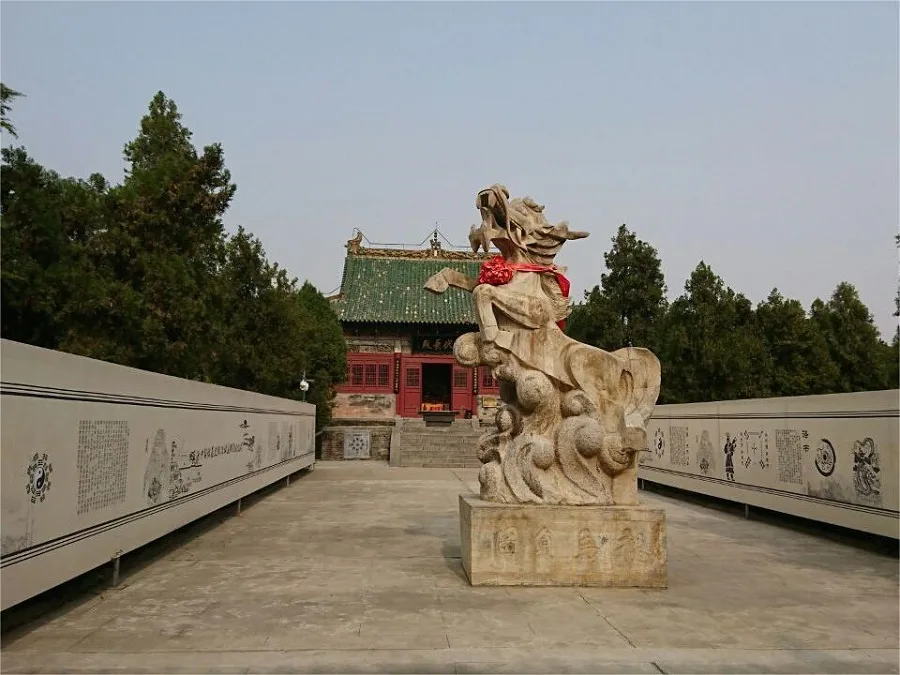Longma Futu Temple (龙马负图寺), established in the fourth year of Yonghe reign of Emperor Mu of Jin Dynasty (348 AD), stands as the first sacrificial site erected along the ancient path of the Tu River to honor the achievements of Fu Xi, the “Ancestor of Humanity.” In ancient times, there was a river called Tu River in the eastern part of Mengjin, which converged with the Yellow River. One day, a dragon horse (Longma) emergered from the river and gave a book to Fuxi. Based on the book, Fuxi developed the Bagua Diagrams. He used them to interpret the evolution of all things and the order of human relations, invented writing, established marriage customs, and taught fishing and hunting, marking the end of the primitive era and laying the foundation for Chinese civilization.
As a result, Longma Futu Temple has since become the “origin of the Bagua Diagram,” and Fu Xi is revered as the”Ancestor of Civilization” of the Chinese nation.
Table of Contents
- Basic Information
- Location and Transportation
- Highlights of Longma Futu Temple
- Vlog about Longma Futu Temple
- Other Attractions in Mengjin County
Basic Information
| Estimated Length of Tour | 0.5 – 1 hour |
| Ticket Price | 30 RMB |
| Opening Hours | 8.00- 17.30 |
| Telephone Number | 0086-0379-60600507 |
Location and Transportation
Longma Futu Temple is situated in Leihe Village, Huimeng Town, Mengjin District, Luoyang. To reach Longma Futu Temple from Luoyang, visitors can take a shuttle bus from Luoyang Bus Station to Huimeng Town or take Bus No. 85 from Luoyang City to the Leihe Station. From Leihe Station, it’s a short walk to Longma Futu Temple.
Highlights of Longma Futu Temple

Longma Futu Temple is characterized by its three-courtyard architectural layout. The first courtyard comprises the mountain gate and the drum and bell tower. Hanging above the mountain gate are inscriptions of the temple’s name, “龙马负图寺,” personally written by Professor Liu Dajun, a renowned contemporary expert in Yi studies and the President of the Chinese Association of Yi Studies, as well as a three-character plaque of “伏羲庙” written by Ren Farong, President of the China Daoist Association. These plaques, along with the majestic mountain gate and the simple yet elegant drum and bell tower, create a magnificent scene. Upon entering the mountain gate, visitors are greeted by a statue of a dragon-horse, depicting the creature with a dragon’s head and a horse’s body, symbolizing its journey through the waves.

The second courtyard houses the Fuxi Hall, a single-eaved gable-roofed building with glazed tiles and decorative ridges adorned with mythical beasts. It employs a mixed brick and wood structure. Inside the hall, there are over twenty inscriptions, such as “The Ancient Path of Tu River” and “The Ancient River Diagram,” among others. These ancient inscriptions, with their vigorous strokes and ancient style, are considered rare treasures. The hall also features a statue of Fuxi, a full-size map of the Fuxi Temple, and stone tablets inscribed with poems and essays by scholars and literati from various dynasties.
The third courtyard houses the main hall, the Three Emperors Hall, which features a double-eaved hip roof structure. Perched atop a raised platform, the hall stands 21 meters tall and spans 30 meters wide. Inside, it enshrines statues of the Three Emperors: Fuxi, Yan Emperor, and Huangdi, with Fuxi positioned in the center and the Yan Emperor and Huangdi flanking him on the left and right, respectively.



